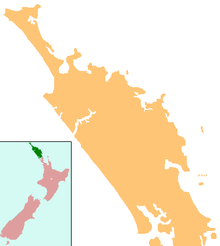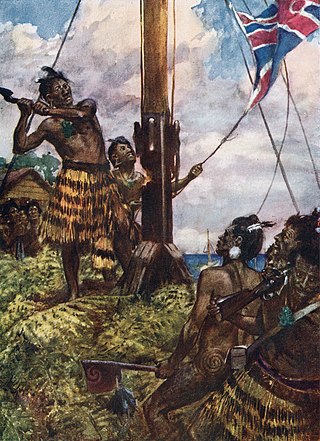
The Flagstaff War, also known as Heke's War, Hōne Heke's Rebellion and the Northern War, was fought between 11 March 1845 and 11 January 1846 in and around the Bay of Islands, New Zealand. The conflict is best remembered for the actions of Hōne Heke who challenged the authority of the British by cutting down the flagstaff on Flagstaff Hill at Kororāreka. The flagstaff had been a gift from Hōne Heke to James Busby, the first British Resident. The Northern War involved many major actions, including the Battle of Kororāreka on 11 March 1845, the Battle of Puketutu on 8 May 1845, the Battle of Ōhaeawai on 23 June 1845 and the siege of Ruapekapeka Pā from 27 December 1845 to 11 January 1846.
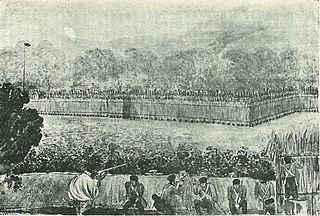
The Battle of Ōhaeawai, part of the Flagstaff War, was fought in July 1845 at Ōhaeawai in Northland, New Zealand. The battle was between British forces and their allies from the local Ngāpuhi tribe of Māori on one side, and other Ngāpuhi, led by Te Ruki Kawiti, a prominent rangatira (chief), on the other side. The battle was notable for establishing that an appropriately built fortified pā could withstand bombardment from cannon fire, with a frontal assault by soldiers suffering heavy casualties.

Tāmati Wāka Nene was a Māori rangatira (chief) of the Ngāpuhi iwi (tribe) who fought as an ally of the British in the Flagstaff War of 1845–46.
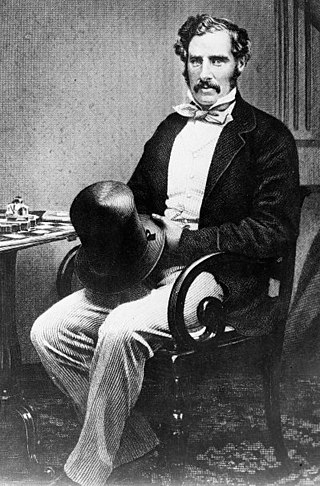
Sir George Grey, KCB was a British soldier, explorer, colonial administrator and writer. He served in a succession of governing positions: Governor of South Australia, twice Governor of New Zealand, Governor of Cape Colony, and the 11th premier of New Zealand. He played a key role in the colonisation of New Zealand, and both the purchase and annexation of Māori land.
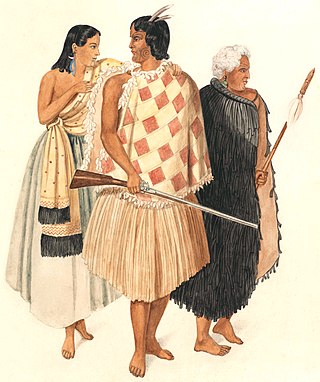
Te Ruki Kawiti was a prominent Māori rangatira (chief). He and Hōne Heke successfully fought the British in the Flagstaff War in 1845–46.

Russell, also known by the Māori name Kororāreka, is a town in the Bay of Islands, in New Zealand's far north. It was the first permanent European settlement and seaport in New Zealand.

Hōne Wiremu Heke Pōkai, born Heke Pōkai and later often referred to as Hōne Heke, was a highly influential Māori rangatira (chief) of the Ngāpuhi iwi (tribe) and a war leader in northern New Zealand; he was affiliated with the Ngati Rahiri, Ngai Tawake, Ngati Tautahi, Te Matarahurahu and Te Uri-o-Hua hapū (subtribes) of Ngāpuhi. Hōne Heke fought with Hongi Hika, an earlier war leader of the Ngāpuhi, in the Musket Wars. Hōne Heke is considered the principal instigator of the Flagstaff War in 1845–46.

Ngāpuhi is a Māori iwi associated with the Northland regions of New Zealand centred in the Hokianga, the Bay of Islands, and Whangārei.

Henry Williams was the leader of the Church Missionary Society (CMS) mission in New Zealand in the first half of the 19th century.
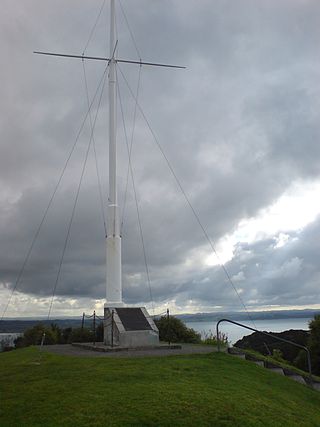
Flagstaff Hill overlooks the Bay of Islands, New Zealand. Directly north of the small historical village of Russell, the flagstaff on the hill played a significant role in early relations between the local Māori of the Ngāpuhi iwi and early British colonials.
The following lists events that happened during 1845 in New Zealand.

Eruera Maihi Patuone was a Māori rangatira (chief), the son of the Ngāti Hao chief Tapua and his wife Te Kawehau. His exact birth year is not known, but it is estimated that he was at least 108 years old when he died.

The Battle of Ruapekapeka was an engagement that took place from late December 1845 to mid-January 1846 between British forces, under the command of Lieutenant Colonel Henry Despard, and Māori warriors of the Ngāpuhi iwi (tribe), led by Hōne Heke and Te Ruki Kawiti, during the Flagstaff War in the Bay of Islands region of New Zealand.
HMS Hazard was an 18-gun Favorite-class sloop of the Royal Navy. She was one of four Favorite-class ship sloops, which were a ship-rigged and lengthened version of the 1796 Cruizer-class brig-sloop. All four ships of the class were ordered on 10 June 1823. She was launched in 1837 from Portsmouth Dockyard.
Tītore, sometimes known as Tītore Tākiri, was a rangatira (chief) of the Ngāpuhi iwi (tribe). He was a war leader of the Ngāpuhi who led the war expedition against the Māori tribes at East Cape in 1820 and 1821. He also led the war expeditions to Tauranga and Maketu in 1832 and 1833, following the Girls' War incident at Kororāreka in the Bay of Islands.
The Girls’ War is the name given to fighting on the beach at Russell, New Zealand, then known as Kororāreka, in March 1830 between the northern and southern hapū (subtribe) within the Ngāpuhi iwi (tribe).
Nōpera Panakareao was a New Zealand tribal leader, evangelist and assessor. Of Māori descent, he identified with the Te Rarawa iwi.
Maihi Paraone Kawiti was a New Zealand tribal leader. Of Māori descent, he identified with the Ngāti Hine hapū of the Ngāpuhi iwi. He was born in Waiomio, Northland, New Zealand in 1807. His father was Te Ruki Kawiti. One of his sons was Kirihi Te Riri Maihi Kawiti.

Pōmare II, originally named Whiria, was a Māori rangatira (chief) of the Ngāpuhi iwi (tribe) in New Zealand and the leader of the Ngāti Manu hapū (subtribe) of the Ngāpuhi. He was the nephew of Pōmare I, his mother Haki being the elder sister of Pōmare I. When he succeeded his uncle as leader of the Ngāti Manu he took his uncle's names, Whētoi and Pōmare. He is referred to as Pōmare II, so as to distinguish him from his uncle.

The Battle of Puketutu was an engagement that took place on 8 May 1845 between British forces, under the command of Lieutenant Colonel William Hulme, and Māori warriors, led by Hōne Heke and Te Ruki Kawiti, during the Flagstaff War in the Bay of Islands region of New Zealand.

